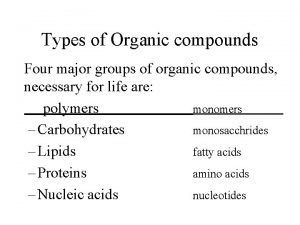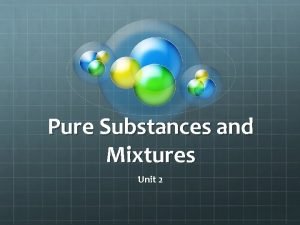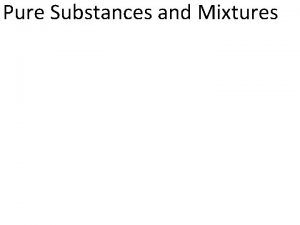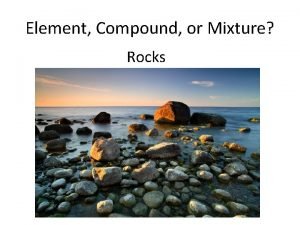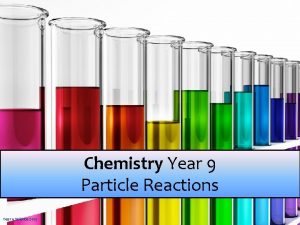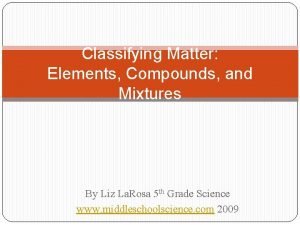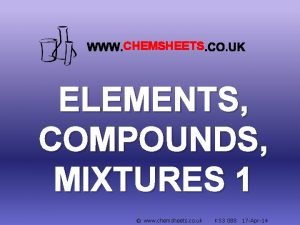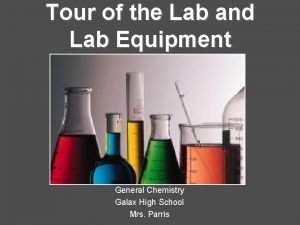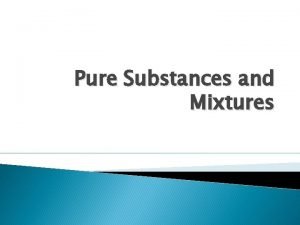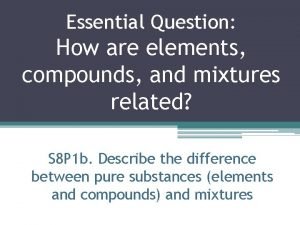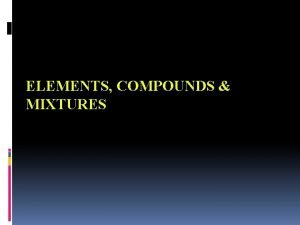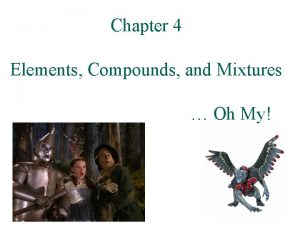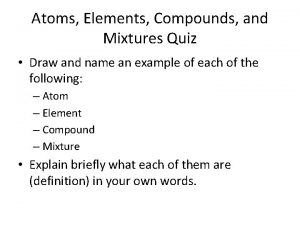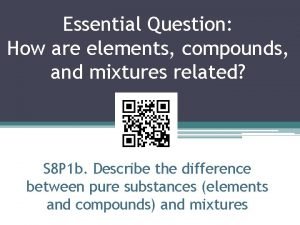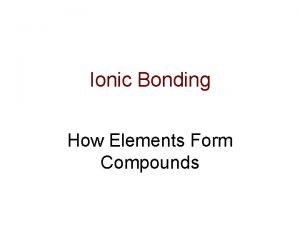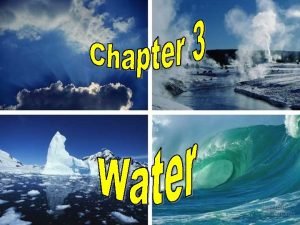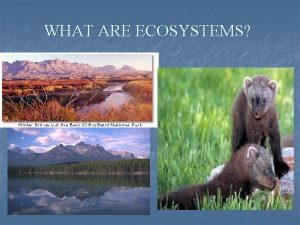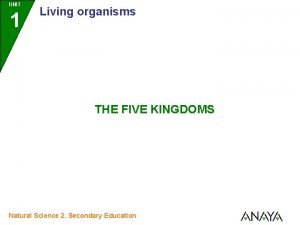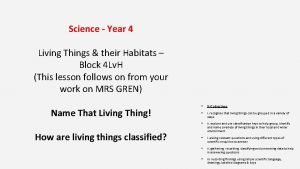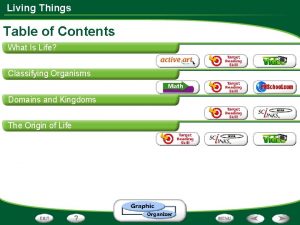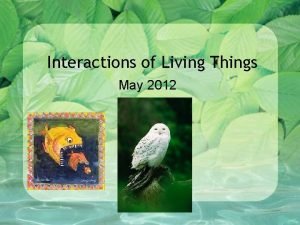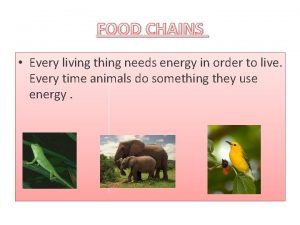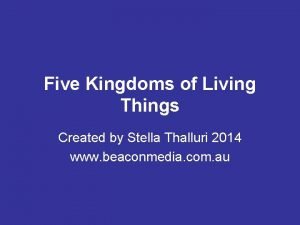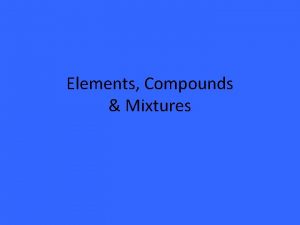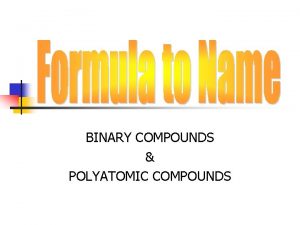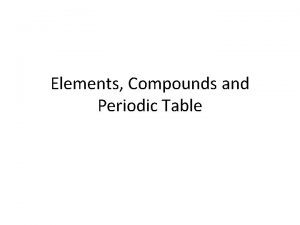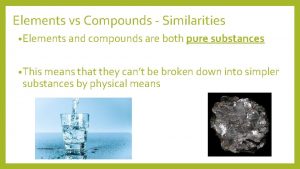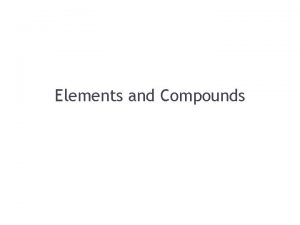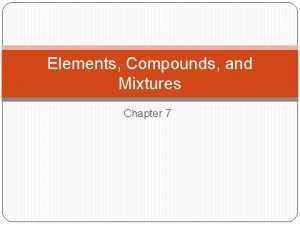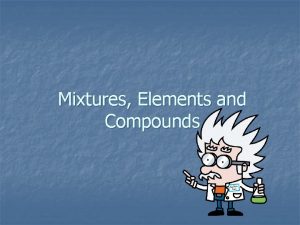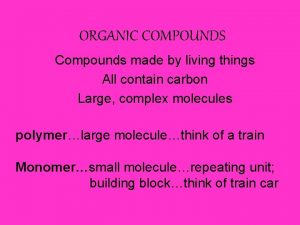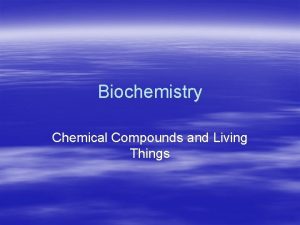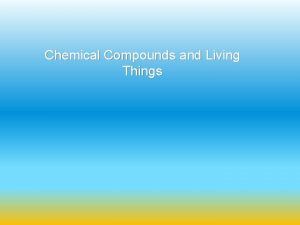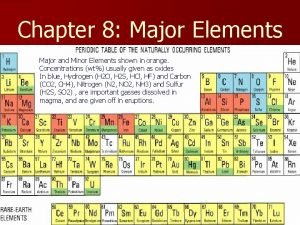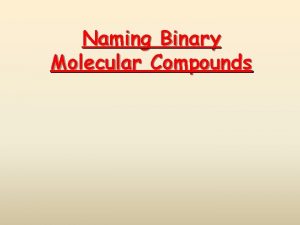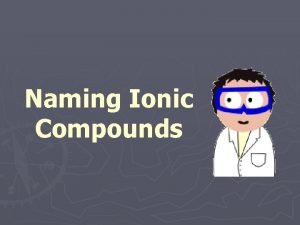Compounds in Living Things Major elements in living









































- Slides: 41

Compounds in Living Things

Major elements in living things • • Carbon (C) Hydrogen (H) Oxygen (O) Nitrogen (N) • Organic compounds contain carbon • Carbon forms 4 VERY stable covalent bonds • Outer energy level? C • How many bonds?

Carbon bonds • Carbon can form long chains or rings by attaching to itself • Polymerization – joining monomers to form polymers

What is a monomer? n n Monomer - smallest unit of a macromolecule Polymer - a large chain of monomers

What is an organic molecule? n n n Contains C and H May contain N, O, P, and/or S SPONCH = all possible elements

What types of organic molecules exist? n n Carbohydrates Lipids Proteins Nucleic Acids Carbs Lipids Proteins

Brainstorm n What do you know about these molecules: n n n Carbohydrates Lipids Proteins Nucleic Acids What do their names make you think of? Do you know anything about their structures?

Carbohydrates n What are they in simple terms? n n n What do they do for us? n n Sugars Starches Energy storage!! (Both long and short term) What’s the monomer? n A monosaccharide (glucose, fructose, etc. )

Carbohydrates n What do they look like? n Monosaccharide (glucose/fructose)



Animation: Polymers Right click on animation / Click play © 2012 Pearson Education, Inc.

How do you break larger molecules (for example, polymers) into monomers? More specifically, how would you convert one polysaccharide molecule into multiple monosaccharide molecules?


Examples n n n Monosaccharide (glucose/fructose) Disaccharide (sucrose/lactose/maltose) Polysaccharide (starch/glycogen/cellulose)

Nucleic Acids n What is it in simple terms? n n DNA and RNA What does it do for us? n Stores hereditary information

Lipids n What are they? n n Fats, oils, and waxes What do they do for us? n n n Store energy Act as chemical messengers (hormones) Form cell membranes

Examples of Lipids n Triglycerides n Steroids n Phospholipids

Triglycerides n What the components? n n Glycerol backbone Three fatty acid chains

Triglycerides H H - C - OH H Glycerol O H H H H HO – C - C – C – C – C – C - H H H H H O H H H H HO – C - C – C = C – C - H H H Fatty acid chains

Dehydration Synthesis builds triglycerides Glycerol 3 fatty acid chains Triglyceride 3 water

Triglycerides n n n Types of triglycerides include: Fats - solid at room temp, found in animals Oils - liquid at room temp, found in plants

Saturated Fat • Have no double bonds between carbons in fatty acid chains. • Pack together tightly (no kinks in chains).

Unsaturated Fat • Contain at least one double bond between carbons in fatty acid chains • Kinks make molecules more spread out • Monounsaturated – one double bond • Polyunsaturated – multiple double bonds

Saturated vs. Unsaturated Fat

Proteins n What is the monomer? n Amino acids


Amino acids: classified based on chemical features of their variable groups. The chemical properties of variable groups allow proteins to fold into unique shapes.

Figure 3. 11 B Amino acids: classified based on chemical features of their variable groups. Hydrophobic Leucine (Leu) Hydrophilic Serine (Ser) Aspartic acid (Asp) The chemical properties of variable groups allow proteins to fold into unique shapes.

The Peptide Bond Which kind of reaction is this? Dipeptide = 2 amino acids linked

Dehydration Synthesis!

Dehydration Synthesis!

How can there be so many different proteins? n n Proteins can be 1000 s of amino acids long… Think about how many words that you can form with 26 letters… (and words aren’t even close to 1000 letters long)

Different proteins have different shapes

Protein shape dictates protein function

Examples of Proteins n Hemoglobin n Carries O 2 and CO 2 in red blood cells

Examples of Proteins n Cell proteins: n n n Cell receptors (sit on the surface of a cell) that allow cells to “talk” to one another Cytoskeleton proteins – sit inside the cell and act like a skeleton to hold its shape Proteins on the surface of the body n Keratin, collagen, elastin n found in hair, fingernails, and skin

Cell Structural Proteins

Proteins on the outside of the body

Examples of Proteins n Some Hormones n n insulin, glucagon, growth hormone Enzymes n Speed up chemical reactions

Proteins - Summary n What do they do for us? n n n EVERYTHING! Structural components of cells and bodies Cell to cell communication Hemoglobin (Transport O 2 and CO 2) Chemical messengers (hormones) Enzymes (speed up chemical reactions)
 Cho cho chon chonp
Cho cho chon chonp Venn diagram of living and non living things
Venn diagram of living and non living things 7 life proceses
7 life proceses What is the smallest living unit
What is the smallest living unit Covalent bond and ionic bond venn diagram
Covalent bond and ionic bond venn diagram Four types of organic compound
Four types of organic compound Element molecule compound mixture worksheet
Element molecule compound mixture worksheet Types of mixtures
Types of mixtures Pure substances and mixtures worksheet answers
Pure substances and mixtures worksheet answers Mixture of compounds diagram
Mixture of compounds diagram Is lemonade a compound or mixture
Is lemonade a compound or mixture Is a bag of m&ms a mixture or pure substance
Is a bag of m&ms a mixture or pure substance Elements and compounds examples
Elements and compounds examples Difference between mixture and compund
Difference between mixture and compund Classifying elements compounds and mixtures
Classifying elements compounds and mixtures Chemsheets
Chemsheets Chemistry in biology section 2 chemical reactions
Chemistry in biology section 2 chemical reactions Chapter 6 chemistry in biology
Chapter 6 chemistry in biology Striker lab equipment
Striker lab equipment Mixture matter graphic organizer
Mixture matter graphic organizer Study jams elements and compounds
Study jams elements and compounds Homogeneous mixture
Homogeneous mixture How elements combine to form compounds
How elements combine to form compounds Elements compounds and mixtures oh my
Elements compounds and mixtures oh my Elements compounds and mixtures quiz
Elements compounds and mixtures quiz Mixture of elements
Mixture of elements Chapter 6 section 1 atoms elements and compounds
Chapter 6 section 1 atoms elements and compounds Ionic compound aluminum and oxygen
Ionic compound aluminum and oxygen Major themes in things fall apart
Major themes in things fall apart Why is water important to living things
Why is water important to living things Live n living
Live n living Unit 1
Unit 1 Life's structure and classification answers key
Life's structure and classification answers key Living things meaning
Living things meaning Ecosystem living and nonliving things
Ecosystem living and nonliving things Sample classification of organisms
Sample classification of organisms Jackal linnaean system
Jackal linnaean system What are the six kingdoms
What are the six kingdoms Living things 20
Living things 20 How many links are there in a food chain
How many links are there in a food chain What is consumers animals
What is consumers animals 5 kingdoms of life
5 kingdoms of life





